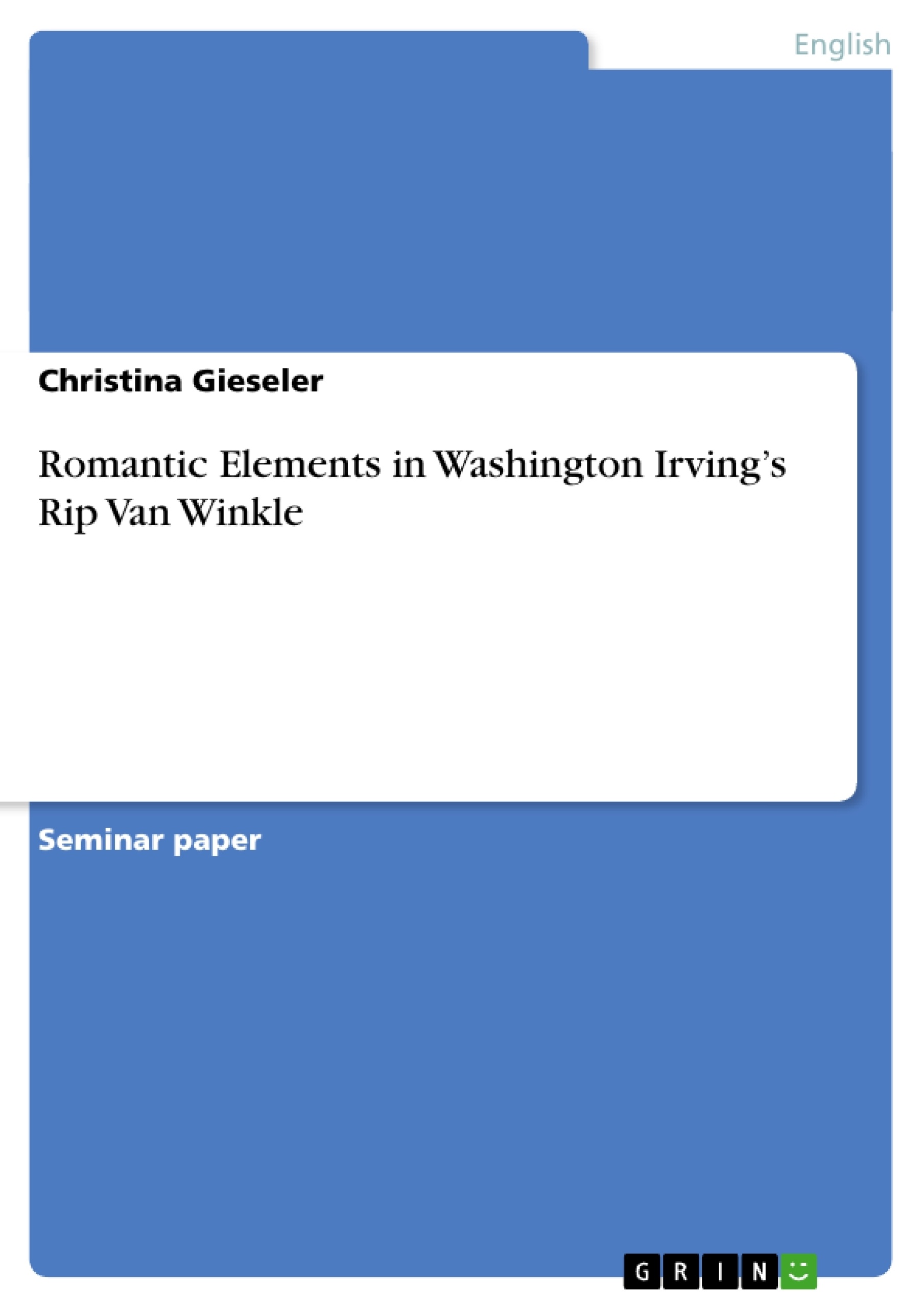Washington Irving was one of the “first notable fiction writers of the American romantic movement” (Keenan 970). His sketch book with tales such as “Rip Van Winkle” “made Irving the first American author to attain an international reputation” (Fender 165). Whereas Irving’s prior work, the History of New York (1809) is written in a neoclassical1 tone right in the sense the Age of Reason and Enlightenment, “The Sketch Book [...], showed that Irving had gradually become a romanticist” (cf. Callow and Reilly 76). According to the “Oxford Companion to American Literature”, Romanticism is a “term that is associated with imagination and boundlessness” (Hart 724). Furthermore, it was a movement that “elevated the individual, the passions, and the inner life. Romanticism, a reaction against neoclassicism, stressed strong emotion, imagination, freedom from classical correctness in art forms, and rebellion against social conventions”2.
The goal of this paper is to examine and explain the major romantic elements in Washington Irving’s “Rip Van Winkle”. Therefore, at first the developments and ways of thinking during the Romantic period will be described, and briefly contrasted with those of the Age of Reason and Enlightenment. Then some information will be given on Irving as a romantic writer and the background of the tale of “Rip Van Winkle”. After that several
romantic features will be highlighted within short analyses of parts of the tale. Due to the briefness of the paper, the discussed features are restricted to themes such as “Truth”,
“Individualism” and the depiction of Rip Van Winkle as a common man, as well as the function of nature within the story.
Inhaltsverzeichnis
- Introduction
- American Romanticism 1820-1865
- Washington Irving's “Rip Van Winkle"
- Irving as a Romantic Writer
- The Background of the Story
- Truth as a Theme in "Rip Van Winkle"
- The Narrative Frame
- "Truth" in the Embedded Tale
- Individualism and the Depiction of the Common Man in "Rip Van Winkle"
- The Function of Nature in "Rip Van Winkle"
- Conclusion
- Bibliography
Zielsetzung und Themenschwerpunkte
This paper aims to analyze and explain the major romantic elements present in Washington Irving's "Rip Van Winkle". It will explore the characteristics of the Romantic period, contrasting them with the Age of Reason and Enlightenment. The paper will then delve into Irving's role as a romantic writer and the historical context of "Rip Van Winkle". Finally, it will highlight several romantic features through short analyses of specific sections of the tale, focusing on themes such as "Truth", "Individualism", the depiction of Rip Van Winkle as a common man, and the role of nature in the story.
- Romanticism as a reaction against the Age of Reason and Enlightenment
- Emphasis on individualism, imagination, and emotion
- The depiction of the common man and his struggles
- The importance of nature and its influence on human experience
- The exploration of truth and its subjective nature
Zusammenfassung der Kapitel
The introduction provides an overview of the paper's objectives and scope, highlighting the importance of Washington Irving's "Rip Van Winkle" as a key work of American Romanticism. It briefly contrasts the Romantic period with the Age of Reason and Enlightenment, setting the stage for the subsequent analysis.
The second chapter delves into the characteristics of American Romanticism, exploring its origins, key themes, and prominent authors. It examines the shift from conservative to liberal ideas, the emphasis on individual freedom, and the rejection of rigid social conventions. The chapter also highlights the influence of European Romanticism and the rise of a distinctly American literary tradition.
The third chapter focuses on Washington Irving's "Rip Van Winkle", examining the story's historical context and Irving's role as a romantic writer. It explores the themes of "Truth", "Individualism", and the depiction of Rip Van Winkle as a common man, analyzing how these themes are interwoven within the narrative. The chapter also examines the function of nature in the story, highlighting its symbolic significance and its impact on Rip's journey.
Schlüsselwörter
The key words and focus themes of the text include American Romanticism, Washington Irving, "Rip Van Winkle", individualism, truth, nature, the common man, and the Age of Reason and Enlightenment. The paper explores the romantic elements present in Irving's story, analyzing how they reflect the broader cultural and intellectual shifts of the period.
- Citar trabajo
- Christina Gieseler (Autor), 2007, Romantic Elements in Washington Irving’s Rip Van Winkle, Múnich, GRIN Verlag, https://www.grin.com/document/148711
-

-

-

-
¡Carge sus propios textos! Gane dinero y un iPhone X. -

-
¡Carge sus propios textos! Gane dinero y un iPhone X. -

-
¡Carge sus propios textos! Gane dinero y un iPhone X. -

-
¡Carge sus propios textos! Gane dinero y un iPhone X. -

-
¡Carge sus propios textos! Gane dinero y un iPhone X. -

-
¡Carge sus propios textos! Gane dinero y un iPhone X.

